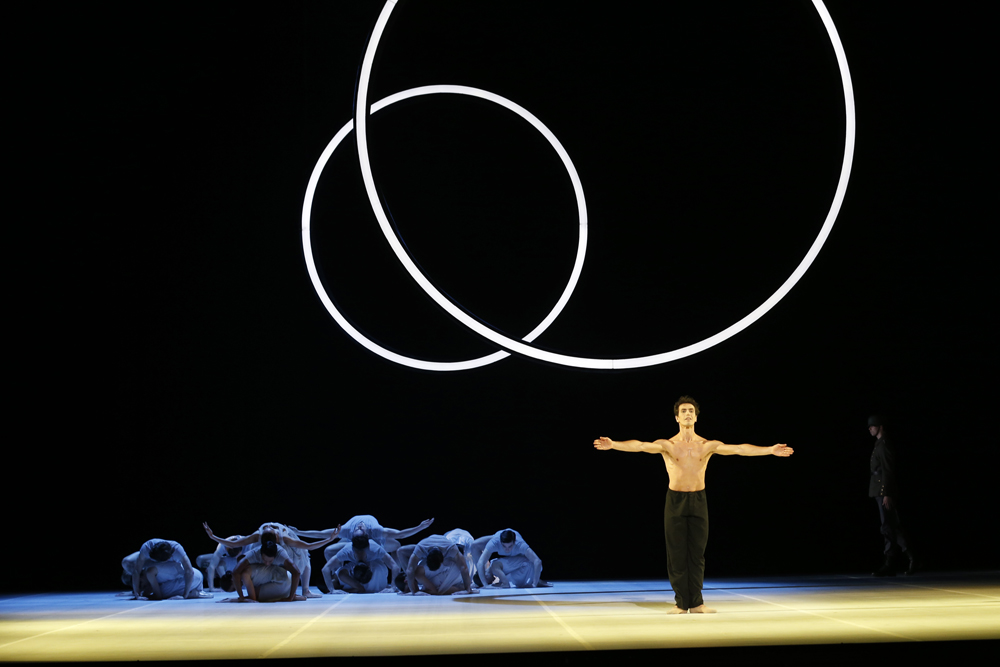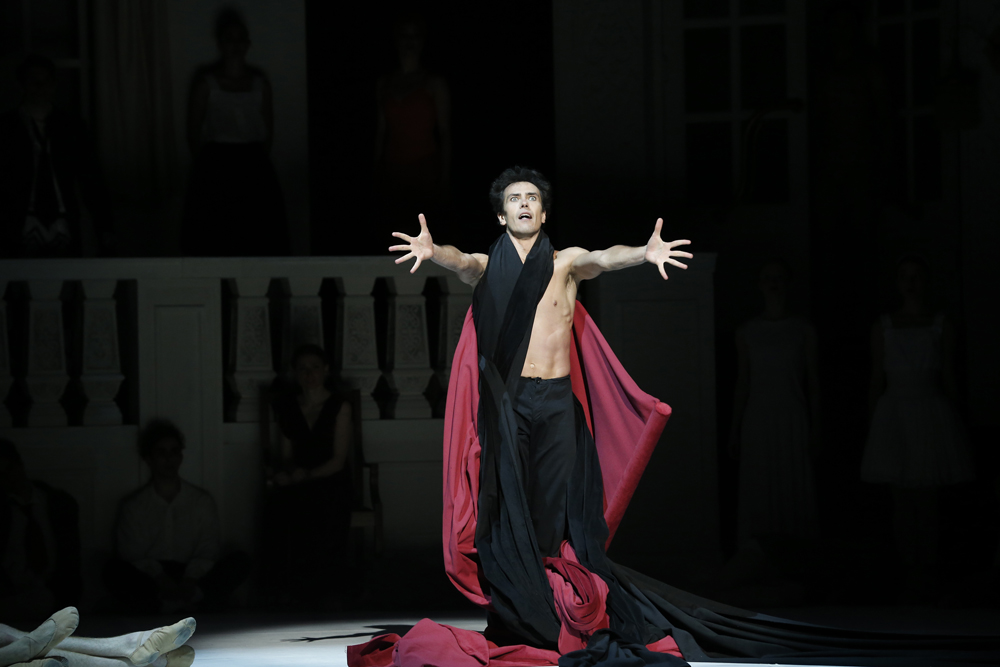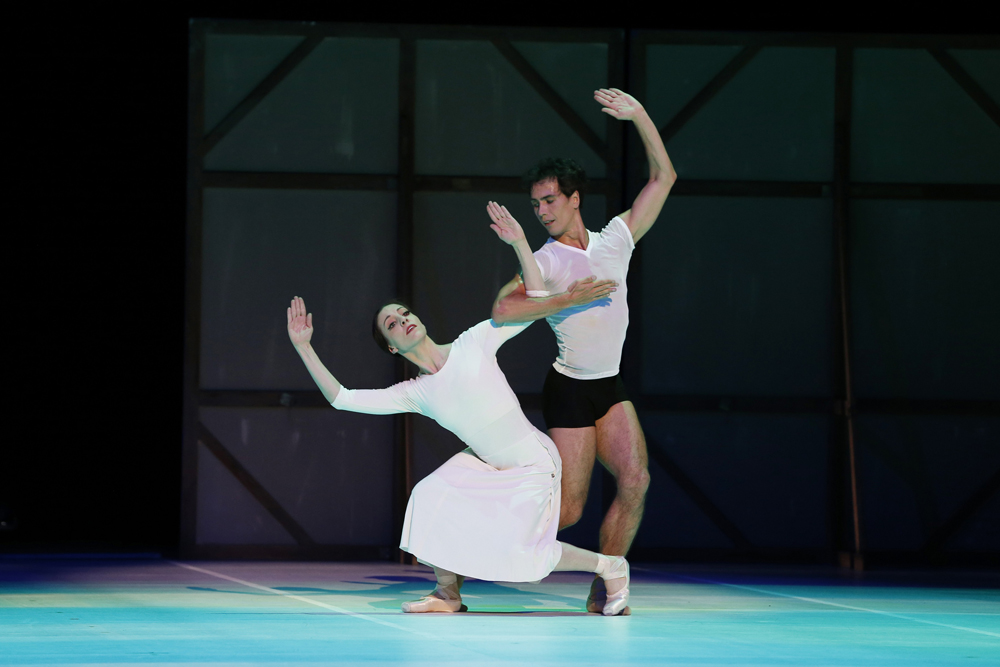★★★★½ Neumeier’s endlessly absorbing dance-drama worships the god of dance.
Arts Centre Melbourne
September 7, 2016
A photograph of Nijinsky from 1911 shows him in costume for Michel Fokine’s Le Spectre de la Rose. His head is slightly lowered and his left arm crosses his body, bent and held high so that it just covers his chin. His right arm is lifted with elbow and wrist curving to frame his head. His garment – it has the outlines of an old-fashioned one-piece bathing suit – is covered with pieces of fabric to simulate petals and reveals the astonishingly powerful thighs that gave Nijinsky his fabled lift-off and thus his ability to apparently levitate and hang in the air. But it’s the eyes that command attention. Enhanced with dark smudges of make-up, Nijinsky’s gaze is direct and very, very inviting. Think Lauren Bacall in To Have and Have Not and you have it. There’s a world of come-hither in that look.
We have no film of Nijinsky performing, only the reports of those who saw him. Of the four works he choreographed, only one, L’après-midi d’un Faune, was notated. It’s not a huge amount to go on but no one argues against Nijinsky’s status as the performing artist who changed the way men danced and what they danced.

Alexandre Riabko. Photo by Jeff Busby
Despite being socially awkward offstage, onstage Nijinsky could be anything. He was the strange and shockingly lascivious creature in L’après-midi d’un faune, the tragic puppet Petrouchka, the thrillingly exotic Golden Slave in Schéhérazade, the soulful Poet in Les Sylphides, the skittish young man in Jeux. As the star dancer in Sergei Diaghilev’s Ballets Russes he became one of the hottest properties on the European stage, a sex symbol whose undies were filched as trophies. As a choreographer he made only a handful of works but they landed like hand grenades.
Nijinsky was always a bit odd, and then much more than that. He was diagnosed with schizophrenia in 1919 and left the stage after a career lasting only a decade. His last public performance was for an invited audience and was held in a St. Moritz hotel ballroom. According to his wife Romola, after an extended silence Nijinsky told his audience, “Now I will dance you the war … the war which you did not prevent.”
The ballroom, with its curved white balcony and glittering chandeliers, is beautifully recreated in John Neumeier’s endlessly absorbing dance-drama Nijinsky (which, remarkably, he also designed), now being performed by The Australian Ballet in Melbourne. The piece poignantly starts here, with some semblance of normalcy. But the dancer’s mind is failing and soon the reality of the room fades and images from Nijinsky’s ballets, his family and his torments mingle freely with the topsy-turvy logic of a fantasy world.

Alexandre Riabko. Photo by Jeff Busby
Neumeier handles this potential minefield with an exquisite touch. Everything emanates from the mind of Vaslav, as Neumeier calls his central figure, and tells you something about him. The fractured evocations of the Ballets Russes days are thrilling as familiar characters dash in and out, just as they might in a dream. Diaghilev appears, carrying the Golden Slave, who then performs a dance of extraordinary sensuality. Here are ballerinas from the Mariinsky in their snowy white tutus, and there the harem girls from Schéhérazade in gorgeously hued robes. The Faun returns again and again with his enigmatic two-dimensional walk and erotic charge.
Neumeier balances this heady rush of mashed-up history with more intimate scenes between Vaslav and Romola and, in Act II, with members of his family. Here we also see Petrouchka, clad in a black-and-white version of his costume – a superb inspiration – as one of war’s victims. The puppet’s pain and that of the world are inextricably tangled together.
As all this might suggest, a working knowledge of Nijinsky’s ballets is exceptionally helpful to getting the most from the evening, although long-time patrons of The Australian Ballet will have had some exposure via the company’s four-year project leading up to the Ballets Russes’ centenary in 2009. It’s certainly a coup for the AB to have secured Nijinsky but even better than the coup factor is that Nijinsky could not be more different from the full-length narrative ballets usually on offer from The Australian Ballet, with their stylistic unity and crystal-clear linear storylines. Nijinsky pushes the boat out a bit and the company is being stretched.

Leanne Stojmenov and Alexandre Riabko. Photo by Jeff Busby
On that score it was interesting to note that Neumeier made a number of very last-minute casting changes for opening night and also brought in his own man, Hamburg Ballet’s Alexandre Riabko, to play the title role (Neumeier is Artistic Director at Hamburg). Usually the AB insists on casting from the company for opening night, which is laudable, but Neumeier’s control over his work is absolute in all respects. Riabko has a very long association with the role and the level of his immersion was profound. So hats off to Amy Harris, an AB senior artist, making her Romola debut with technical refinement and intense character. Interestingly, while Romola is at best a divisive figure as far as history is concerned, Neumeier treats her sympathetically while not shying away from the rumours of infidelity. Adam Bull smouldered darkly as Diaghilev and Leanne Stojmenov gave a brilliantly etched Bronislava Nijinska.
Ako Kondo took on a dazzling array of roles as the Ballerina (and must be a dab hand at costume changes, of which there are many) and François-Eloi Lavignac was terrific as Vaslav’s afflicted brother Stanislav. A special mention must go to Brett Simon, a heart-wrenching Petrouchka.
Neumeier’s choice of music is impeccable and it was played full-heartedly by Nicolette Fraillon and Orchestra Victoria. Rimsky-Korsakov’s luscious score for Schéhérazade (movements one, two and four) in the first half is set alongside Chopin, Schumann and Shostakovich. The second half is given over to Shostakovich’s brooding, troubling Symphony No 11.
Neumeier’s fascination for his subject runs deep. He is a noted collector of Nijinsky material and made several ballets on subjects associated with the dancer before, in 2000, choreographing this tremendously moving work for Hamburg Ballet. His knowledge is a given and his great love and admiration are palpable. Nijinsky can make a whole raft of claims in terms of choreographic richness and stunning scenic design and these are more than enough reason to see the ballet. More compelling than anything, though, is Neumeier’s compassion for the poor soul who used to be god of the dance. The standing ovation in Melbourne was well judged.
Nijinsky is performed in Melbourne until September 17; then Adelaide, October 14-19; and Sydney, November 11-28.
Deborah Jones is national dance critic for The Australian.











Comments
Log in to join the conversation.